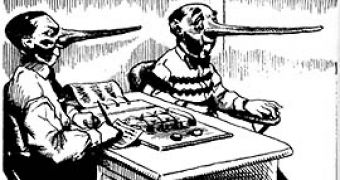By applying computer technology to the emotion-driven nature of nonverbal communication social psychologist Mark Frank has devised methods to recognize and accurately read the conscious and unconscious facial expressions that suggest deceit.
"Fleeting facial expressions are expressed by minute and unconscious movements of facial muscles like the frontalis, corregator and risorius," Frank says, "and these micro-movements, when provoked by underlying emotions, are almost impossible for us to control."
Paul Ekman, who was Frank's mentor during his post-doctoral years at the University of California, and his colleague Wallace Friesen had devised a numbering system for all of these minute movements: for example, left and right eyebrows up is 1; down, 2; eyebrows pulled together, 4; upper eyelid raised, 5, and so on. Ekman and Friesen conducted extensive cross-cultural research and found that a wide range of facial expressions related to specific emotions are identical from culture to culture.
Based on their research, Frank has identified and isolated specific and sometimes involuntary movements of the 44 human facial muscles linked to fear, distrust, distress and other emotions related to deception. Then, he developed computer programs that automated Ekman's numbering process, making it possible to identify automatically every facial expression, including those tied to deceit, shown by subjects in taped interviews.
Frank's system proved to be so successful in identifying suspects that he has been asked to assist judges, health and police agencies, including the Los Angeles Police Department, the U.S. Federal Judiciary, the Bureau of Alcohol, Tobacco and Firearms and Department of Homeland Security, and other legal, medical and law enforcement communities from Singapore to Scotland Yard.
"I want to make it clear that one micro-expression or collection of them is not proof of anything," Frank says. "They have meaning only in the context of other behavioral cues, and even then are not an indictment of an individual, just very good clues."
He added: "This identification skill is one that some police employ successfully. They work in a high-stakes profession that helps them develop what they would call an acute intuitive sense. What we have done is quantify it, automate it, prove its effectiveness and teach it very effectively."

 14 DAY TRIAL //
14 DAY TRIAL //